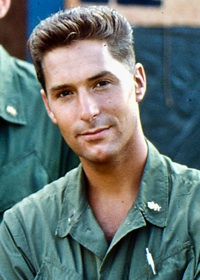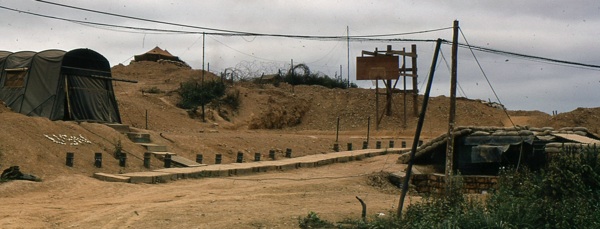 Jon E. Schiff, DDS
Jon E. Schiff, DDS
Colonel
Navy Dentist, Cam Lo Hill
December 1967-December 1968
It was early December 1967 when I arrived in Vietnam and was sent to Phu Bai to join the 3rd Marine Division. I was a dental officer, a lieutenant, not a grunt like so many of the fine young men I would meet in this strange place. I spent my first night in Phu Bai in a muddy-floored tent next to a 155mm artillery battery that was firing outgoing rounds all night long in a constant rain. I had volunteered for Vietnam to get away from a failed marriage. That first night I began to wonder, “What have I done to my life?”
I reported the next morning to the dental commanding officer, a colonel. I had already been in the Navy for three years and now, at the ripe age of 26, was considered an old, experienced dentist, as most of my contemporaries were right out of school. The colonel said he needed someone with experience to go to a place called Cam Lo Hill. Marine field commanders there had men who were unable to go on patrol or sit a night listening post because they had become “dental casualties.” The commanders wanted a Navy dentist near the field Marines to treat them and relieve their pain so that they could return to the fighting.
Units rotated in and out of Cam Lo, including the 1st Battalion, 9th Marines; the 3rd Battalion, 4th Marines; the 3rd Tank Battalion and various 81mm mortar crews and artillery units firing 8-inch guns and other artillery pieces from the hill.
My assistant and driver was Dental Technician 3rd Class Larry Kent, from Pennsylvania. We took a jeep one day each week from Cam Lo to Con Thien to treat the Marines there. The ground commander at Con Thien didn’t allow any Marine on his hill without a helmet and flak jacket. I would line up the Marines with dental problems in a bunker, usually the battalion aid station, and then inject Xylocaine from the front of the line to the end. After everyone was numb, I would go back to the beginning of the line and start removing abscessed teeth and treating infections. We used a box of portable instruments, throwaway gauze and a flashlight or lantern.
At Cam Lo Hill, I was given an old trailer filled with empty sandbags and converted it into both my clinic and hooch for the next five months. I outfitted it with an air compressor, put a 55-gallon drum of water on the roof, hooked up a faucet my father had sent and soon had running water. There were no other buildings at Cam Lo, only bunkers. These places, including Con Thien, were taking a lot of artillery and mortar rounds, so everyone lived below ground in some type of bunker. My trailer, however, was above ground, and I noticed it took on more and more shrapnel holes. One night while reading by candlelight, I got up when the rounds started, ran out and jumped into a slit trench. When I got back, I found a jagged hole through the back of my lawn chair. After that, I imposed on the 11th Engineers to dig a revetment into which they rolled my clinic/hooch.
One night, in early January, the whole sky lit up with parachute flares, tracers (red and green—ours and theirs) and lots of firing in Cam Lo village near the base of our hill. I sat on top of my hooch thinking it was quite a show. All of a sudden, I heard what I thought were wasps or bees buzzing past my ears. Just as quickly, one of these wasps turned green as it flew by my head. Any farm boy from southern Indiana knows that wasps and bees don’t swarm at night. These were tracers, and I realized I’d better get off the top of my hooch and into a slit trench.

I really came to like the Marines at Cam Lo Hill. The mortar crew would let me drop the shells down the 81mm tubes, and I’d watch the 8-inch howitzer crews fire their missions. I had the Seabees scrape off a flat place for a basketball court, and we would have basketball games every evening after chow. I usually ate with the gun crews because they had better chow.
February 4, 1968, started out as a quiet Sunday. Hue City to the southeast had been captured, and Khe Sanh to the southwest was under siege. Being in Leatherneck Square just south of the DMZ, we were often taking fire, so when Tet had started on the 1st, it didn’t seem all that different. We had an afternoon basketball game in progress on my court when suddenly an ear-shattering “crack” exploded nearby. Someone shouted “Incoming!” and we all ran for cover. The next round smashed right in the middle of the basketball court. I lay in my slit trench trying to burrow deeper in the bottom of the hole. Several more rounds came crashing in, CRACK, CRACK, CRACK. I burrowed even deeper, trying to get into a fetal position. In the distance I could hear someone screaming “Doc!” I thought,“Christ, I don’t want to get out of this hole.”
The scream came again, “Doc! Help!”
These Marines were my friends, my buddies. I wanted to help and was quite capable of doing so. Before leaving for Vietnam, I had spent a month at Camp Pendleton, training at its Field Medical Service School where all Naval medical personnel must pass through before going to a combat zone. How could I lie there, relatively safe, while some of them might be wounded? They called me by my name, perhaps unusual, but I seemed to be the only “corpsman” available.
As I leapt from the hole with my helmet bouncing up and down on my head, I thought, “This is crazy, I can’t hear the incoming rounds with this over my ears,” so I threw off my helmet and ran as fast as I could to the sound of the screaming Marines. What I came upon was a scene from Dante’s Inferno.
The first 122mm rocket had hit adjacent to the Marine mess tent during noon chow. It was an open, flat area with no real cover, and wounded were everywhere. The first one I encountered had a ruptured femoral artery spurting blood. I pulled off my belt to tie a tourniquet above the wound to stop the bleeding. I glanced to my left and saw a wounded Marine on his back who had taken a chunk of shrapnel to the forehead and was now reflex vomiting, drowning from it. I yelled to a nearby corpsman, “Give me your scalpel!”
He did, and I quickly opened the wounded Marine’s throat at his trachea, took a ballpoint pen from my pocket, unscrewed it and inserted the tube into the opening. Immediately, I heard the life-giving air rush in and out. Two other Marines, Paul Scaglione and Mauricio Orasco, helped me move him, but before we could get him to a bunker, the next barrage of 122mm rockets came in, bracketing us as they landed. There was no place to run to. I just lay down over my wounded buddy. I didn’t know it at the time, but I had an audience of other Marines watching the whole ordeal from their bunkers surrounding the impact zone.
Another Marine performed the bravest act I saw that day. One 122mm round hit near our ammo bunker, causing the inside of it to ignite. I don’t know the Marine’s name, but he ran into the burning bunker with a fire extinguisher and put the fire out. If the projectiles inside had cooked off, it would have leveled much of our hilltop. In spite of the attack, there was no mayhem or panic. The Marines then policed up their areas, and life went on.
Fortunately, no one was killed in action that day, but 14 Marines were wounded. Later, we had two Marines killed in a jeep just outside our wire when an RPG hit their jeep and the gas tank exploded. I had to identify their bodies from dental records.
I worked out of Cam Lo for five months, and spent the next seven months at Quang Tri Combat Base near Dong Ha. In May 1968, the U.S. Marine Corps awarded me the Bronze Star Medal with the Combat “V” for my actions on February 4, when I performed the emergency tracheotomy and tended to the injured Marines. My tour ended in December 1968. I continued to practice dentistry in the Navy, including aboard the aircraft carrier Saratoga. I left the Navy in 1972 and went on to have a successful dental career in Florida while finishing out my time in the Army Reserve and retiring as a colonel.
In the 40 years since these events took place, I have tried to put them out of my mind, but I realize that I’ve thought of them every day, and quite often at night. Strange as my year in Vietnam was, it had ended not with the question I asked myself the first night, “What have I done to my life?” but rather with the satisfaction of looking at what I had done to help and serve my Marines in a combat zone. It turns out 1968 was the biggest year of the war, with more Marine casualties than in any other year.
When Navy medical personnel serve with the Marine Corps in a combat zone, they wear Marine Green, not their Navy uniforms. An unknown Navy corpsman from an unknown war best summed up the way we Navy guys feel about our Marine buddies: “…in a larger sense, our greatest honor came many years ago at Camp Pendleton Medical Service School when we were issued the green uniform of the U.S. Marine Corps. Yes, we were issued the very uniform that you earned by enduring the great ordeal of boot camp. I know what the uniform cost you, yet you gave it to me. To have been considered worthy to have worn the uniform of the U.S. Marine Corps is the highest honor that you and I will ever have.”
The events in Vietnam changed my life forever. Even in civilian life, I feel, to this day, more comfortable in the company of others who have experienced the military world, especially Vietnam. I’ve served with all four branches, but always, always, I remember my Marines.
This story was originally published in the February 2009 issue of Vietnam magazine.




